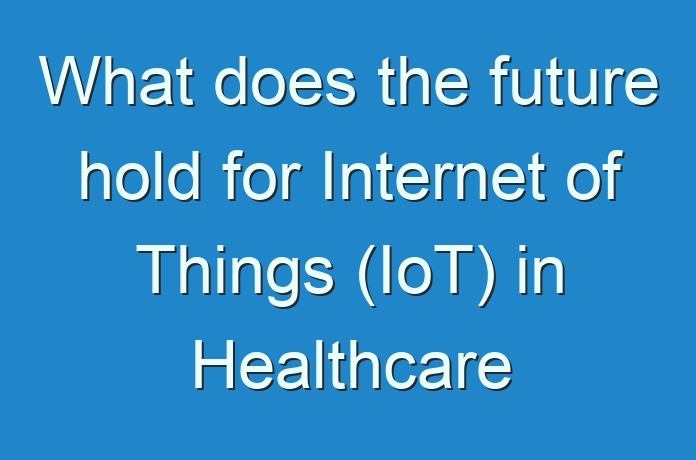
According to a new market report published by Transparency Market Research titled “IoT in Healthcare Market, By Component (Hardware [Portable {On-body Wearable, Others}, Non-Portable], Software, Services), By Application (Telemedicine, Medication Management, Clinical Operations, Patient Monitoring, Connected Imaging, Others), By End-Use (Hospitals, Pharmaceuticals, Clinics & Laboratories), By Technology (Bluetooth, Wi-Fi, NFC, Zigbee, RFID, Others) – Global Industry Analysis, Size, Share, Growth, Trends and Forecast, 2019 – 2027”. The global IoT in healthcare market is expected to reach US$ 469.4 Bn by 2027, expanding at a CAGR of 20.9% from 2019 to 2027. North America held the highest market share for IoT in healthcare market in 2019.
The internet connected devices has been introduced to monitor and diagnose patients in various forms. Tracking health information is vital for most of the patients whether the data comes from electrocardiograms, fetal monitors, blood glucose levels or temperature monitors. Most of these measures require follow-up interaction with healthcare professionals creating an opportunity for smarter electronic devices for delivering more valuable data by reducing the need for direct physician-patient interaction.
Most of the hospitals have started installing ‘smart beds’ enabling them to detect when the patient is attempting to get up and when it is occupied. It can also self-adjust to ensure the appropriate support and pressure is applied to the patient without manual intervention. Another benefit of IoT in healthcare is integration with home medical dispensers for automatically uploading data on cloud when medication which requires attention for cases when medication isn’t taken or any other case which requires the health professionals to be alerted.
Request a sample to get extensive insights into the IoT in Healthcare Market https://www.transparencymarketresearch.com/sample/sample.php?flag=S&rep_id=11975

The IoT technology implementations is likely to raise concerns regarding data security and privacy. Most of the devices us secure communication methods with the cloud but can still be vulnerable to the hackers. The U.S. Food and Drug Administration has offered guidelines regarding the medical devices and asked regulators to monitor the connected devices used by the patients.
The IoT in healthcare market can be segmented into component, application, end-use, and technology. By component, the industry can be classified into hardware, software and services. The hardware component has been further classified into portable diagnostic devices and non-portable diagnostic devices. The portable diagnostic devices are further segmented into on-body wearable and others. By application, the industry is segmented into telemedicine, medication, management, clinical operations, patient monitoring, connected imaging and others. By end-use, the industry is classified into hospitals, pharmaceuticals and laboratories. The IoT in healthcare industry has been segmented into Bluetooth, Wi-Fi, NFC, Zigbee, RFID, and others which include cellular, satellite, Zwave, and EnOcean.
North America IoT in healthcare market is expected to continue its dominance over the forecast period. Growing digitization in healthcare management systems across major hospitals, clinics and healthcare institutions is expected to drive the IoT in healthcare market over the forecast period. The U.S. had the highest market share compared to Canada and Mexico catering the industry demand for North America region. Asia Pacific is expected to have the highest CAGR from 2019 to 2027. Emerging economies such as India and China is expected to support the demand by holding about 60% of the market revenue from these countries in the Asia Pacific region.
Request For Covid19 Impact Analysis Across Industries And Markets – https://www.transparencymarketresearch.com/sample/sample.php?flag=covid19&rep_id=11975
Key industry participants of the IoT in healthcare market are AdhereTech Inc., Cerner Corporation, IBM Corporation, Qualcomm Technologies Inc., Cisco Inc., General Electric Company, Ericsson AB, Honeywell International, Medtronic Inc., SAP SE, Vodafone and Zebra Technologies. Some of the key factors attributing to the players are the global competitiveness, mergers and acquisitions and new product launches along with having forward and backward integration strategies.
Market Segmentation:
IoT in Healthcare Market Analysis, by Component
- Hardware
- Portable Diagnostic Devices
- On-body Wearable
- Others
- Non-Portable Diagnostic Devices
- Portable Diagnostic Devices
- Software
- Services
IoT in Healthcare Market Analysis, by Application
- Telemedicine
- Medication Management
- Clinical Operations
- Patient Monitoring
- Connected Imaging
- Others
IoT in Healthcare Market Analysis, by End-Use
- Hospitals
- Pharmaceuticals
- Clinics & Laboratories
IoT in Healthcare Market Analysis, by Technology
- Bluetooth
- Wi-Fi
- NFC
- Zigbee
- RFID
- Others (Cellular, Satellite, Zwave, EnOcean)
IoT in Healthcare Market Analysis, by Region
- North America
- The U.S.
- Canada
- Rest of North America
- Europe
- Germany
- France
- UK
- Rest of Europe
- Asia-Pacific
- China
- India
- Japan
- Rest of Asia Pacific
- Middle-East & Africa
- Saudi Arabia
- South Africa
- Rest of MEA
- South America
- Brazil
- Rest of South America
Stuck in a neck-to-neck competition with other brands? Request a custom report on IoT in Healthcare Market https://www.transparencymarketresearch.com/sample/sample.php?flag=CR&rep_id=11975
US Office Contact
90 State Street, Suite 700
Albany, NY 12207
Tel: +1-518-618-1030
USA – Canada Toll Free: 866-552-3453
Email: sales@transparencymarketresearch.com
Website: https://www.transparencymarketresearch.com





